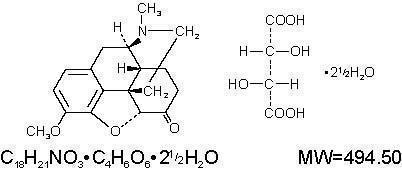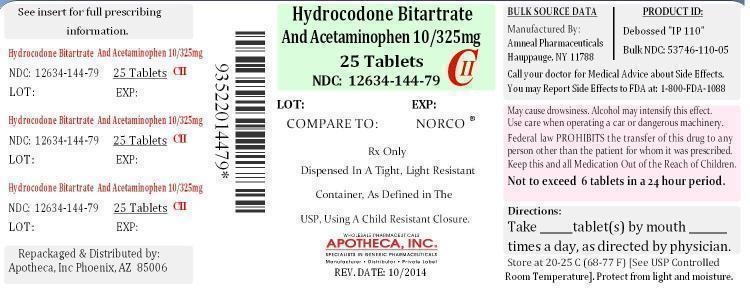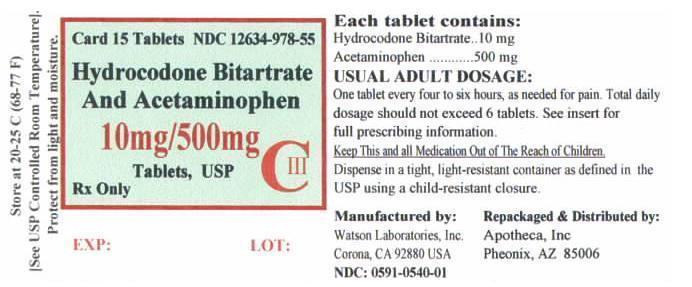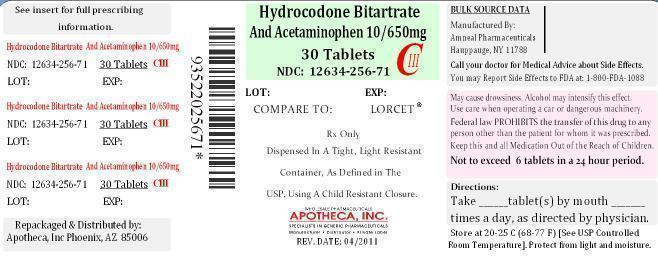HYDROCODONE BITARTRATE AND ACETAMINOPHEN tablet
Hydrocodone Bitartrate and Acetaminophen by
Drug Labeling and Warnings
Hydrocodone Bitartrate and Acetaminophen by is a Prescription medication manufactured, distributed, or labeled by Apotheca, Inc.. Drug facts, warnings, and ingredients follow.
Drug Details [pdf]
-
DESCRIPTION
Hydrocodone bitartrate and acetaminophen is supplied in tablet form for oral administration
Hydrocodone bitartrate is an opioid analgesic and antitussive and occurs as fine, white crystals or as a crystalline powder. It is affected by lightThe chemical name is
4 5a Epoxy 3 methoxy 17 methylmorphinan 6 one tartrate1 1 hydrate 2 5 It has the following structural formula

Acetaminophen, 4 Hydroxyacetanilide, a slightly bitter white odorless crystalline powder is a nonopiate non salicylate analgesic and antipyretic. It has the following structural formula

Hydrocodone bitartrate and acetaminophen tablets USP for oral administration are available in the following strengths
- 10mg 325mg 10mg Hydrocodone Bitartrate USP 325mg Acetaminophen USP
Discontinued the following strengths
- 10mg 500mg 10mg Hydrocodone Bitartrate USP 500mg Acetaminophen USP
- 10mg 650mg 10mg Hydrocodone Bitartrate USP 650mg Acetaminophen USP
-
BOXED WARNING
(What is this?)
BOXED WARNING
HEPATOTOXICITY
Acetaminophen has been associated with cases of acute liver failure, at times resulting in liver transplant and death. Most of the cases of liver injury are associated with the use of acetaminophen at doses that exceed 4000 milligrams per day, and often involve more than one acetaminophen-containing product. -
CLINICAL PHARMACOLOGY
Hydrocodone is a semisynthetic narcotic analgesic and antitussive with multiple actions qualitatively similar to those of codeine. Most of these involve the central nervous system and smooth muscle. The precise mechanism of action of hydrocodone and other opiates is not known, although it is believed to relate to the existence of opiate receptors in the central nervous system. In addition to analgesia, narcotics may produce drowsiness, changes in mood and mental clouding
The analgesic action of acetaminophen involves peripheral influences, but the specific mechanism is as yet undetermined. Antipyretic activity is mediated through hypothalamic heat regulating centers. Acetaminophen inhibits prostaglandin synthetase. Therapeutic doses of acetaminophen have negligible effects on the cardiovascular or respiratory systems; however, toxic doses may cause circulatory failure and rapid, shallow breathing
-
Pharmacokinetics
The behavior of the individual components is described below
HydrocodoneFollowing a 10 mg oral dose of hydrocodone administered to five adult male subjects, the mean peak concentration was 23.6 ± 5.2 ng/mL. Maximum serum levels were achieved at 1.3 ± 0.3 hours and the half-life was determined to be 3.8 ± 0.3 hours. Hydrocodone exhibits a complex pattern of metabolism including O-demethylation, Ndemethylation and 6-keto reduction to the corresponding 6-a- and 6-b-hydroxy-metabolites. See Overdosage for toxicity information.
Acetaminophen
Acetaminophen is rapidly absorbed from the gastrointestinal tract and is distributed throughout most body tissues. The plasma half-life is 1.25 to 3 hours, but may be increased by liver damage and following overdosage. Elimination of acetaminophen is principally by liver metabolism (conjugation) and subsequent renal excretion of metabolites. Approximately 85% of an oral dose appears in the urine within 24 hours of administration, most as the glucuronide conjugate, with small amounts of other conjugates and unchanged drug. See OVERDOSAGE for toxicity information
- INDICATIONS AND USAGE
- CONTRAINDICATIONS
-
WARNINGS
Hepatotoxicity
Acetaminophen has been associated with cases of acute liver failure, at times resulting in liver transplant and death. Most of the cases of liver injury are associated with the use of acetaminophen at doses that exceed 4000 milligrams per day, and often involve more than one acetaminophen-containing product. The excessive intake of acetaminophen may be intentional to cause self-harm or unintentional as patients attempt to obtain more pain relief or unknowingly take other acetaminophen-containing products
The risk of acute liver failure is higher in individuals with underlying liver disease and in individuals who ingest alcohol while taking acetaminophen
Instruct patients to look for acetaminophen or APAP on package labels and not to use more than one product that contains acetaminophen. Instruct patients to seek medical attention immediately upon ingestion of more than 4000 milligrams of acetaminophen per day, even if they feel well
Serious skin reactions
Rarely, acetaminophen may cause serious skin reactions such as acute generalized exanthematous pustulosis (AGEP), Stevens-Johnson Syndrome (SJS), and toxic epidermal necrolysis (TEN), which can be fatal. Patients should be informed about the signs of serious skin reactions, and use of the drug should be discontinued at the first appearance of skin rash or any other sign of hypersensitivity
Hypersensitivity anaphylaxis
There have been post-marketing reports of hypersensitivity and anaphylaxis associated with use of acetaminophen. Clinical signs include swelling of the face, mouth, and throat, respiratory distress, urticaria, rash, pruritis, and vomiting. There were infrequent reports of life-threatening anaphylaxis requiring emergency medical attention. Instruct patients to discontinue Hydrocodone Bitartrate and Acetaminophen Tablets, USP immediately and seek medical care if they experience these symptoms. Do not prescribe Hydrocodone Bitartrate and Acetaminophen Tablets, USP for patients with acetaminophen allergy
Head Injury and Increased Intracranial Pressure
The respiratory depressant effects of narcotics and their capacity to elevate cerebrospinal fluid pressure may be markedly exaggerated in the presence of head injury, other intracranial lesions or a preexisting increase in intracranial pressure. Furthermore, narcotics produce adverse reactions which may obscure the clinical course of patients with head injuries
Acute Abdominal Conditions
The administration of narcotics may obscure the diagnosis or clinical course of patients with acute abdominal conditions
Misuse, Abuse, and Diversion of Opioids
Hydrocodone bitartrate and acetaminophen tablets contain hydrocodone, an opioid agonist, and is a Schedule III controlled substance. Opioid agonists have the potential for being abused and are sought by abusers and people with addiction disorders, and are subject to diversion.
Hydrocodone bitartrate and acetaminophen tablets can be abused in a manner similar to other opioid agonists, legal or illicit. This should be considered when prescribing or dispensing hydrocodone bitartrate and acetaminophen tablets in situations where the physician or pharmacist is concerned about an increased risk of misuse, abuse or diversion (see DRUG ABUSE AND DEPENDENCE).
-
PRECAUTIONS
General
Special Risk Patients:
As with any narcotic analgesic agent, hydrocodone bitartrate and acetaminophen tablets should be used with caution in elderly or debilitated patients and those with severe impairment of hepatic or renal function, hypothyroidism, Addison's disease, prostatic hypertrophy or urethral stricture. The usual precautions should be observed and the possibility of respiratory depression should be kept in mind.
Cough Reflex:
Hydrocodone suppresses the cough reflex; as with all narcotics, caution should be exercised when hydrocodone bitartrate and acetaminophen tablets are used postoperatively and in patients with pulmonary disease
-
Information for Patients
Hydrocodone, like all narcotics, may impair the mental and/or physical abilities required for the performance of potentially hazardous tasks such as driving a car or operating machinery; patients should be cautioned accordingly.
Alcohol and other CNS depressants may produce an additive CNS depression, when taken with this combination product, and should be avoided.
Hydrocodone may be habit-forming. Patients should take the drug only for as long as it is prescribed, in the amounts prescribed, and no more frequently than prescribed
- Laboratory Tests
-
Drug Interactions
Patients receiving other narcotic analgesics, antihistamines, antipsychotics, antianxiety agents, or other CNS depressants (including alcohol) concomitantly with hydrocodone bitartrate and acetaminophen tablets may exhibit an additive CNS depression. When combined therapy is contemplated, the dose of one or both agents should be reduced.
The use of MAO inhibitors or tricyclic antidepressants with hydrocodone preparations may increase the effect of either the antidepressant or hydrocodone
- Drug and Laboratory Test Interactions
- Carcinogenesis, Mutagenesis, Impairment of Fertility
-
Pregnancy
Pregnancy Category C
There are no adequate and well-controlled studies in pregnant women. Hydrocodone bitartrate and acetaminophen tablets should be used during pregnancy only if the potential benefit justifies the potential risk to the fetus
Nonteratogenic Effects
Babies born to mothers who have been taking opioids regularly prior to delivery will be physically dependent. The withdrawal signs include irritability and excessive crying, tremors, hyperactive reflexes, increased respiratory rate, increased stools, sneezing, yawning, vomiting, and fever. The intensity of the syndrome does not always correlate with the duration of maternal opioid use or dose. There is no consensus on the best method of managing withdrawal
- Labor and Delivery
-
Nursing Mothers
Acetaminophen is excreted in breast milk in small amounts, but the significance of its effects on nursing infants is not known. It is not known whether hydrocodone is excreted in human milk. Because many drugs are excreted in human milk and because of the potential for serious adverse reactions in nursing infants from hydrocodone and acetaminophen, a decision should be made whether to discontinue nursing or to discontinue the drug, taking into account the importance of the drug to the mother
- Pediatric Use
-
Geriatric Use
Clinical studies of hydrocodone bitartrate and acetaminophen tablets did not include sufficient numbers of subjects aged 65 and over to determine whether they respond differently from younger subjects. Other reported clinical experience has not identified differences in responses between the elderly and younger patients. In general, dose selection for an elderly patient should be cautious, usually starting at the low end of the dosing range, reflecting the greater frequency of decreased hepatic, renal, or cardiac function, and of concomitant disease or other drug therapy.
Hydrocodone and the major metabolites of acetaminophen are known to be substantially excreted by the kidney. Thus the risk of toxic reactions may be greater in patients with impaired renal function due to the accumulation of the parent compound and/or metabolites in the plasma. Because elderly patients are more likely to have decreased renal function, care should be taken in dose selection, and it may be useful to monitor renal function.
Hydrocodone may cause confusion and over-sedation in the elderly; elderly patients generally should be started on low doses of hydrocodone bitartrate and acetaminophen tablets and observed closely
-
ADVERSE REACTIONS
The most frequently reported adverse reactions are lightheadedness, dizziness, sedation, nausea and vomiting. These effects seem to be more prominent in ambulatory than in nonambulatory patients, and some of these adverse reactions may be alleviated if the patient lies down.
Other adverse reactions include
Central Nervous System
Drowsiness, mental clouding, lethargy, impairment of mental and physical performance, anxiety, fear, dysphoria, psychic dependence, mood changes
Gastrointestinal System
Prolonged administration of hydrocodone bitartrate and acetaminophen tablets may produce constipation
Genitourinary System
Ureteral spasm, spasm of vesical sphincters and urinary retention have been reported with opiates
Respiratory Depression
Hydrocodone bitartrate may produce dose-related respiratory depression by acting directly on the brain stem respiratory center (see OVERDOSAGE)
-
DRUG ABUSE AND DEPENDENCE
Misuse, Abuse, and Diversion of Opioids
Hydrocodone bitartrate and acetaminophen tablets contain hydrocodone, an opioid agonist, and is a Schedule II controlled substance. Hydrocodone bitartrate and acetaminophen, and other opioids, used in analgesia can be abused and are subject to criminal diversion.
Addiction is a primary, chronic, neurobiologic disease, with genetic, psychosocial, and environmental factors influencing its development and manifestations. It is characterized by behaviors that include one or more of the following: impaired control over drug use, compulsive use, continued use despite harm, and craving. Drug addiction is a treatable disease utilizing a multidisciplinary approach, but relapse is common.
“Drug seeking” behavior is very common in addicts and drug abusers. Drug-seeking tactics include emergency calls or visits near the end of office hours, refusal to undergo appropriate examination, testing or referral, repeated “loss” of prescriptions, tampering with prescriptions and reluctance to provide prior medical records or contact information for other treating physician(s). “Doctor shopping” to obtain additional prescriptions is common among drug abusers and people suffering from untreated addiction.
Abuse and addiction are separate and distinct from physical dependence and tolerance. Physical dependence usually assumes clinically significant dimensions only after several weeks of continued opioid use, although a mild degree of physical dependence may develop after a few days of opioid therapy. Tolerance, in which increasingly large doses are required in order to produce the same degree of analgesia, is manifested initially by a shortened duration of analgesic effect, and subsequently by decreases in the intensity of analgesia. The rate of development of tolerance varies among patients. Physicians should be aware that abuse of opioids can occur in the absence of true addiction and is characterized by misuse for non-medical purposes, often in combination with other psychoactive substances. Hydrocodone bitartrate and acetaminophen, like other opioids, may be diverted for non-medical use. Record-keeping of prescribing information, including quantity, frequency, and renewal requests is strongly advised.
Proper assessment of the patient, proper prescribing practices, periodic re-evaluation of therapy, and proper dispensing and storage are appropriate measures that help to limit abuse of opioid drugs
-
OVERDOSAGE
Following an acute overdosage, toxicity may result from hydrocodone or acetaminophen
Signs and Symptoms
Hydrocodone
Serious overdose with hydrocodone is characterized by respiratory depression (a decrease in respiratory rate and or tidal volume, Cheyne-Stokes respiration, cyanosis), extreme somnolence progressing to stupor or coma, skeletal muscle flaccidity, cold and clammy skin, and sometimes bradycardia and hypotension. In severe overdosage, apnea, circulatory collapse, cardiac arrest and death may occur
Acetaminophen
In acetaminophen overdosage: dose-dependent, potentially fatal hepatic necrosis is the most serious adverse effect. Renal tubular necrosis, hypoglycemic coma, and thrombocytopenia may also occur
Early symptoms following a potentially hepatotoxic overdose may include
nausea, vomiting, diaphoresis and general malaise
Clinical and laboratory evidence of hepatic toxicity may not be apparent until 48 to 72 hours post-ingestion
In adults, hepatic toxicity has rarely been reported with acute overdoses of less than 10 grams, or fatalities with less than 15 grams
Treatment
A single or multiple overdose with hydrocodone and acetaminophen is a potentially lethal polydrug overdose, and consultation with a regional poison control center is recommended.
Immediate treatment includes support of cardiorespiratory function and measures to reduce drug absorption. Vomiting should be induced mechanically, or with syrup of ipecac, if the patient is alert (adequate pharyngeal and laryngeal reflexes). Oral activated charcoal (1 g/kg) should follow gastric emptying. The first dose should be accompanied by an appropriate cathartic. If repeated doses are used, the cathartic might be included with alternate doses as required. Hypotension is usually hypovolemic and should respond to fluids. Vasopressors and other supportive measures should be employed as indicated. A cuffed endotracheal tube should be inserted before gastric lavage of the unconscious patient and, when necessary, to provide assisted respiration.
Meticulous attention should be given to maintaining adequate pulmonary ventilation. In severe cases of intoxication, peritoneal dialysis, or preferably hemodialysis may be considered. If hypoprothrombinemia occurs due to acetaminophen overdose, vitamin K should be administered intravenously.
Naloxone, a narcotic antagonist, can reverse respiratory depression and coma associated with opioid overdose. Naloxone hydrochloride 0.4 mg to 2 mg is given parenterally. Since the duration of action of hydrocodone may exceed that of the naloxone, the patient should be kept under continuous surveillance and repeated doses of the antagonist should be administered as needed to maintain adequate respiration. A narcotic antagonist should not be administered in the absence of clinically significant respiratory or cardiovascular depression.
If the dose of acetaminophen may have exceeded 140 mg/kg, acetylcysteine should be administered as early as possible. Serum acetaminophen levels should be obtained, since levels four or more hours following ingestion help predict acetaminophen toxicity. Do not await acetaminophen assay results before initiating treatment. Hepatic enzymes should be obtained initially, and repeated at 24-hour intervals.
Methemoglobinemia over 30% should be treated with methylene blue by slow intravenous administration.
The toxic dose for adults for acetaminophen is 10 g
-
DOSAGE AND ADMINISTRATION
Dosage should be adjusted according to the severity of the pain and response of the patient. However, it should be kept in mind that tolerance to hydrocodone can develop with continued use and that the incidence of untoward effects is dose-related.
The usual adult dosage for Hydrocodone Bitartrate and Acetaminophen Tablets USP is
10mg/325mg The usual adult dosage is one tablet every four to six hours as needed for pain. The total daily dosage should not exceed 6 tablets 10mg/500mg The usual adult dosage is one tablet every four to six hours as needed for pain. The total daily dosage should not exceed 6 tablets 10mg/650mg The usual adult dosage is one tablet every four to six hours as needed for pain. The total daily dosage should not exceed 6 tablets -
HOW SUPPLIED
Hydrocodone Bitartrate and Acetaminophen tablets, USP are available in the following strengths:
10mg 325mg 10mg of Hydrocodone Bitartrate and 325mg of Acetaminophen.White to off white, scored, oblong biconvex tablets, debossed
IP110 on obverse and bisected on the reverse
They are supplied as follows- 12634-144-78 Bottle of 12
- 12634-144-85 Bottle of 15
- 12634-144-79 Bottle of 25
- 12634-144-91 Blister Pack UD of 1
- 12634-144-61 Blister Pack Card 10
- 12634-144-52 Blister Pack Card 12
- 12634-144-55 Blister Pack Card 15
10mg 500mg 10mg of Hydrocodone Bitartrate and 500mg of Acetaminophen.Capsule-shaped, blue tablets bisected on one side and debossed
with Watson540 on the other side
DISCONTINUED- 12634-978-95 Bottle of 5
- 12634-978-00 Bottle of 10
- 12634-978-85 Bottle of 15
- 12634-978-71 Bottle of 30
- 12634-978-91 Blister Pack UD of 1
- 12634-978-55 Blister Pack Card of 15
10mg 650mg 10mg of Hydrocodone Bitartrate and 650mg of Acetaminophen. White to off white, scored, oblong, biconvex tablets, debossed
IP114 on obverse, a bisected on the reverse
DISCONTINUED- 12634-256-79 Bottle of 5
- 12634-256-50 Bottle of 50
- 12634-256-91 Blister Pack UD of 1
- Storage
-
PACKAGE LABEL AND PRINCIPAL DISPLAY PANEL
Hydocodone Bitartrate
And Acetaminophen 10 325mg25 Tablets
NDC: 12634-144-79 CII
COMPARE TO NORCO
Rx Only
Repackaged and Distributed by
Apotheca, Inc.
Phoenix, AZ 85006
A Schedule CIII Controlled Drug Substance - DISCONTINUED 12-31-2014
NDC: 12634-978-55 Card 15 Tablets
Each Tablet Contains
Hydocodone Bitartrate 10 mg
Acetaminophen 500 mg
Usual Adult Dosage
See insert for full prescribing information
One tablet every four to six hours, as needed for pain. Total daily dosage should not exceed six tablets
Repackaged and Distributed byApotheca, Inc
Phoenix, AZ 85006
Hydrocodone Bitartrate
And Acetaminophen 10 650mg 30 Tablets CIII - DISCONTINUED 12-31-2013
NDC: 12634-256-71
COMPARE TO LORCET
Rx Only

-
INGREDIENTS AND APPEARANCE
HYDROCODONE BITARTRATE AND ACETAMINOPHEN
hydrocodone bitartrate and acetaminophen tabletProduct Information Product Type HUMAN PRESCRIPTION DRUG Item Code (Source) NDC: 12634-144(NDC:53746-110) Route of Administration ORAL DEA Schedule CII Active Ingredient/Active Moiety Ingredient Name Basis of Strength Strength HYDROCODONE BITARTRATE (UNII: NO70W886KK) (HYDROCODONE - UNII:6YKS4Y3WQ7) HYDROCODONE BITARTRATE 10 mg ACETAMINOPHEN (UNII: 362O9ITL9D) (ACETAMINOPHEN - UNII:362O9ITL9D) ACETAMINOPHEN 325 mg Inactive Ingredients Ingredient Name Strength CROSPOVIDONE (UNII: 68401960MK) MAGNESIUM STEARATE (UNII: 70097M6I30) CELLULOSE, MICROCRYSTALLINE (UNII: OP1R32D61U) POVIDONE (UNII: FZ989GH94E) STEARIC ACID (UNII: 4ELV7Z65AP) Product Characteristics Color white (white-to off white) Score 2 pieces Shape CAPSULE (oblong, biconvex tablets) Size 15mm Flavor Imprint Code IP;110 Contains Packaging # Item Code Package Description Marketing Start Date Marketing End Date 1 NDC: 12634-144-91 1 in 1 BLISTER PACK 2 NDC: 12634-144-61 10 in 1 BLISTER PACK 3 NDC: 12634-144-52 12 in 1 BLISTER PACK 4 NDC: 12634-144-55 15 in 1 BLISTER PACK 5 NDC: 12634-144-78 12 in 1 BOTTLE 6 NDC: 12634-144-85 15 in 1 BOTTLE 7 NDC: 12634-144-79 25 in 1 BOTTLE 8 NDC: 12634-144-71 30 in 1 BOTTLE Marketing Information Marketing Category Application Number or Monograph Citation Marketing Start Date Marketing End Date ANDA ANDA040746 03/20/2009 HYDROCODONE BITARTRATE AND ACETAMINOPHEN
hydrocodone bitartrate and acetaminophen tabletProduct Information Product Type HUMAN PRESCRIPTION DRUG Item Code (Source) NDC: 12634-978(NDC: 0591-0540) Route of Administration ORAL DEA Schedule CIII Active Ingredient/Active Moiety Ingredient Name Basis of Strength Strength HYDROCODONE BITARTRATE (UNII: NO70W886KK) (HYDROCODONE - UNII:6YKS4Y3WQ7) HYDROCODONE BITARTRATE 10 mg ACETAMINOPHEN (UNII: 362O9ITL9D) (ACETAMINOPHEN - UNII:362O9ITL9D) ACETAMINOPHEN 500 mg Inactive Ingredients Ingredient Name Strength CROSPOVIDONE (UNII: 68401960MK) MAGNESIUM STEARATE (UNII: 70097M6I30) CELLULOSE, MICROCRYSTALLINE (UNII: OP1R32D61U) POVIDONE (UNII: FZ989GH94E) STEARIC ACID (UNII: 4ELV7Z65AP) Product Characteristics Color blue (blue) Score 2 pieces Shape CAPSULE (capsule-shape) Size 15mm Flavor Imprint Code watson;540 Contains Packaging # Item Code Package Description Marketing Start Date Marketing End Date 1 NDC: 12634-978-91 1 in 1 BLISTER PACK 2 NDC: 12634-978-55 15 in 1 BLISTER PACK 3 NDC: 12634-978-95 5 in 1 BOTTLE, PLASTIC 4 NDC: 12634-978-00 10 in 1 BOTTLE, PLASTIC 5 NDC: 12634-978-85 15 in 1 BOTTLE, PLASTIC 6 NDC: 12634-978-71 30 in 1 BOTTLE, PLASTIC Marketing Information Marketing Category Application Number or Monograph Citation Marketing Start Date Marketing End Date ANDA ANDA040148 07/01/2008 12/31/2014 HYDROCODONE BITARTRATE AND ACETAMINOPHEN
hydrocodone bitartrate and acetaminophen tabletProduct Information Product Type HUMAN PRESCRIPTION DRUG Item Code (Source) NDC: 12634-256(NDC: 53746-114) Route of Administration ORAL DEA Schedule CIII Active Ingredient/Active Moiety Ingredient Name Basis of Strength Strength HYDROCODONE BITARTRATE (UNII: NO70W886KK) (HYDROCODONE - UNII:6YKS4Y3WQ7) HYDROCODONE BITARTRATE 10 mg ACETAMINOPHEN (UNII: 362O9ITL9D) (ACETAMINOPHEN - UNII:362O9ITL9D) ACETAMINOPHEN 650 mg Inactive Ingredients Ingredient Name Strength CROSPOVIDONE (UNII: 68401960MK) MAGNESIUM STEARATE (UNII: 70097M6I30) CELLULOSE, MICROCRYSTALLINE (UNII: OP1R32D61U) POVIDONE (UNII: FZ989GH94E) STEARIC ACID (UNII: 4ELV7Z65AP) Product Characteristics Color white (white to off white) Score 2 pieces Shape CAPSULE (oblong, biconvex tablets) Size 18mm Flavor Imprint Code IP;114 Contains Packaging # Item Code Package Description Marketing Start Date Marketing End Date 1 NDC: 12634-256-91 1 in 1 BLISTER PACK 2 NDC: 12634-256-79 25 in 1 BOTTLE, PLASTIC 3 NDC: 12634-256-50 50 in 1 BOTTLE, PLASTIC Marketing Information Marketing Category Application Number or Monograph Citation Marketing Start Date Marketing End Date ANDA ANDA040757 03/20/2009 12/31/2013 Labeler - Apotheca, Inc. (051457844) Establishment Name Address ID/FEI Business Operations Apotheca, Inc. 051457844 repack(12634-144, 12634-978, 12634-256)
© 2025 FDA.report
This site is not affiliated with or endorsed by the FDA.